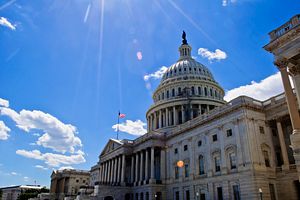The U.S. Senate Foreign Relations Committee has backed the Strategic Competition Act of 2021, which labels China a strategic competitor in multiple areas, including economics, technology, and military security. While there are some legitimate issues between the United States and China, the text of the act is anti-Chinese and many areas of focus are poorly conceived.
Certainly, there are areas of conflict between the United States and China, which have been highlighted by the China-U.S. trade war and other events in recent years. These include the issue of technology transfer, U.S. firms’ ability to compete in China, Chinese human rights abuses, data privacy, and cyber conflict. These are real issues that must be addressed by the United States and its allies as well as by the U.S. and China.
However, the act frames China’s actions in regard to these issues and others in offensive terms. For example, the act states, “It is the policy of the United States, in pursuing strategic competition with the PRC, …to expose the PRC’s use of corruption, repression, coercion, and other malign behavior to attain unfair economic advantage and deference of other nations to its political and strategic objectives.” The text also asserts that “The PRC is promoting its governance model and attempting to weaken other models of governance by— (A) undermining democratic institutions; (B) subverting financial institutions; (C) coercing businesses to accommodate the policies of the PRC; and (D) using disinformation to disguise the nature of [its] actions…”
Having interacted with some Chinese government officials after the trade war began, it is clear that inflammatory rhetoric does very little to achieve an atmosphere of compromise. In fact, anti-Chinese rhetoric from the United States has rendered Chinese officials and other experts quite bitter and confounded.
Whereas in recent decades, the U.S. government was open to interacting with China and its one-party system, the act now assumes that the Chinese Communist Party represents a repressive regime. While China has changed to some extent under Xi Jinping, it has not experienced major disruptions in its political system. This suggests that the U.S. about face with regard to China’s political system has more to do with the United States than with China. What has changed over time is China’s economic and political power across the globe, and it appears that, now that China can compete with the U.S., its political system is seen as a threat or “malign” influence.
True, there are differences in ideology that should have concerned the United States at the outset of China’s opening up process, and certainly after China’s Tiananmen Square massacre. These include human rights abuses and the absence of democratic institution-building. The U.S. chose to ignore these aspects of China’s political regime and built up strong economic and diplomatic ties between the two countries in a bid to take advantage of China’s low-cost labor and loosely enforced environmental regulations. In particular, there was little to no negotiation by the United States to encourage China to become democratic in order to receive more U.S. foreign direct investment or expand trade. If there was a time to bring this issue to the fore, it was in the 1990s and 2000s, while China was still in a nascent development stages, not today, when China has achieved a comfortable middle-income status.
The overall thrust of the Strategic Competition Act of 2021 is that China is an adversary that cannot be negotiated with. The report cites then-Vice President Mike Pence’s statement in 2018 that “Beijing is employing a whole-of-government approach, using political, economic, and military tools, as well as propaganda, to advance its influence and benefit its interests in the United States.” The act specifies that it does not promote military solutions to China-U.S. conflicts, but it does promote U.S. cooperation with allies as well as reinforcement of U.S. capabilities to counter China. The act does not, however, lay out a trajectory in which the United States can cooperate or negotiate with China on some issues, or use a tit-for-tat strategy in which concessions are made by one party to obtain key favors from the other. The latter is a preferred method of mediation by the Chinese, but requires deep knowledge of the other party’s interests and a willingness to give up some bargaining chips at the negotiating table.
Instead, the United States is going around China, which may be beneficial to Washington in the short to medium run. This is not a strategy for the long game, however, in which the two global powers will doubtlessly come to loggerheads on some major topic and find that it is too late to enter into negotiation. At that point, the only viable option will be war.
































